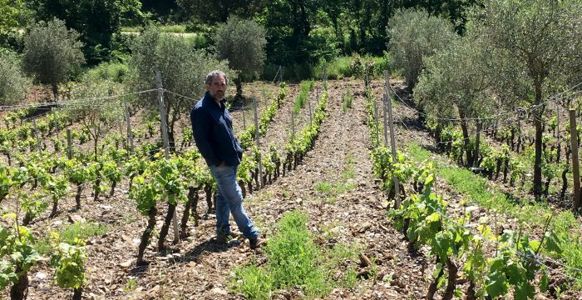Panevino

Panevino Gallery
Thank you to importer Louis/Dressner for this estate profile.
In Italian, “Pane e vino” means “bread and wine.” Gianfranco Manca was raised a baker. At an early age he took over his uncle’s bakery, baking the classic Sardinian breads that he learned to make from his mother and aunts. Their bread is still prized in his town and the bakery was a success. Along with the bakery, plots of land with very old vines had somehow remained in the family despite being neglected for years. They were trained in alberello, the traditional back-braking, low-growing system used on the islands of Italy. While majoritarily Cannonau, over 30 different grapes were planted.
Since he was already an expert at fermentation with bread, Gianfranco believed the natural progression would be to understand wine fermentation with the help of these old vines. He set about rehabilitating them and planted a parcel of new vines in Monica and Carignano del Sulcis, a local strain of the famous grape. And though Gianfranco started making wine in the mid 1980’s, it wasn’t until 2005 that he was ready to put a label on it and offer his interpretation to the rest of the world. What do you say about a winemaker whose self-professed greatest influences are Bob Dylan and Jesus? Gianfranco is a rare soul in the wine business. He is an empath/winemaker. First, his love for the vines is so strong that he says he feels a particular relationship with each one. Furthermore, he thinks the vines tell him what to do with the grapes. He has been working these vines for a long time now, so I can imagine some deeper understanding of one’s vineyards comes through with that much time. As proof, Gianfranco's wines stylistically change from year to year. This also means a new label and name for each wine, each vintage. With each new wine Gianfranco expresses his personal point of view on what he experienced that year. In 2005 the wine was called Perdacoddura and it was above 15.5%, a big, brawny wine. In 2006, the expression of the same wine was called Mariposa, the results of a search for the more elegant and seductive side to the grape. In 2007, a very good harvest, it is called ‘Ogu – which simultaneously means "fire", "eye" and "bud". It is wine born of fire (there was a raging wildfire that year that stopped literally at the next hill over from his vineyards and house) and it is through this wine which Gianfranco presents his vision and through which the world sees him. Of course, minimal treatments (2g of Bordeaux mix) and plowing, no use of systemic treatments, herbicides or pesticides are tolerated at Panevino (we visited an estate in Bossa that was doing a treatment. After artfully haranguing the owner for using these systemic treatments and offering to show him how to get along without them, sensitive Gianfranco became violently ill from the bad air). The vinifications are carried out on the natural yeasts of the vines and cellar culture. All the wines ferment in open-top wood vats, then are aged 12 months in barrique of at least three years. The wines are bottled without fining, filtration or added sulfites. The wines are all certified organic by the AIAB, an Italian organic certification board. In 2008 Gianfranco planted another 1.5 ha of Cannonau from massale selection. In 2009, he had hoped to plant two more, but the weather was not being cooperative last we heard. I am pretty sure they finally were planted. Gianfranco only rarely makes bread these days (mostly classes and demonstrations for children and young adults) but when he does, he must be very careful with clothing and hygiene to keep the two cultures of yeast from intermingling.
Background
- Name of Estate: Panevino
- Region: Sardinia
- Country: Italy
- Proprietor: Gianfranco Manca
- Size: 4 hectares
- Farming: Organic (Not Certified)
- Soils: Schist, decomposed schist, iron rich clay, sand
- Grapes grown: Cannonau, Monica, Carignan, lots of others...
- Fun facts: Gianmarco Manca's self-professed greatest influences are Bob Dylan and Jesus. He believes his mind is as much part of the terroir as the soil and the climate. He is a very, very interesting man.











